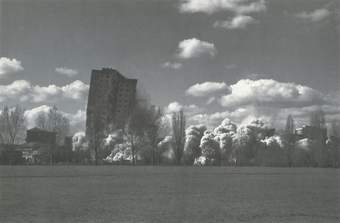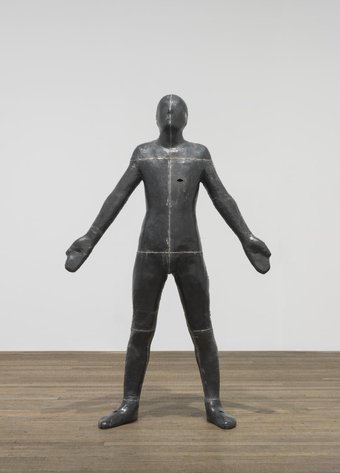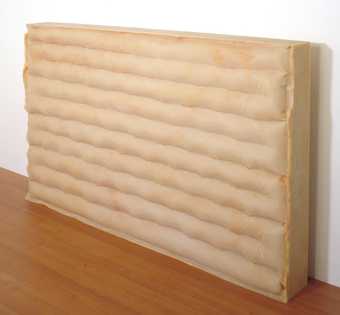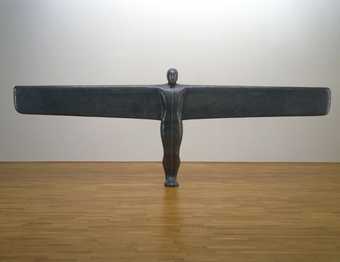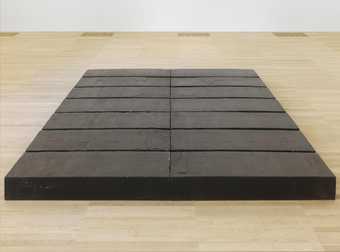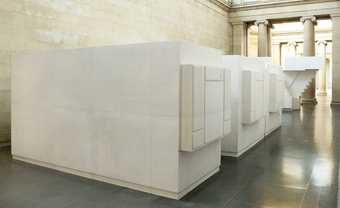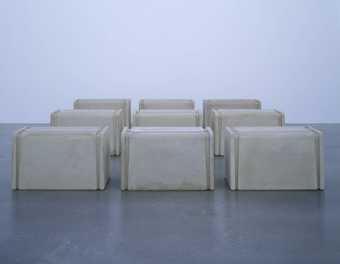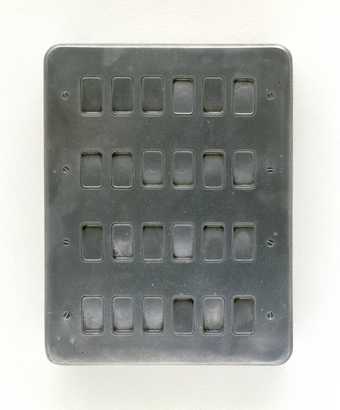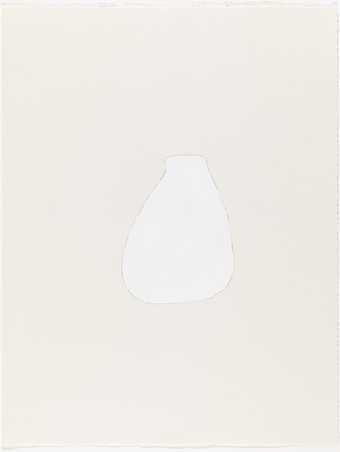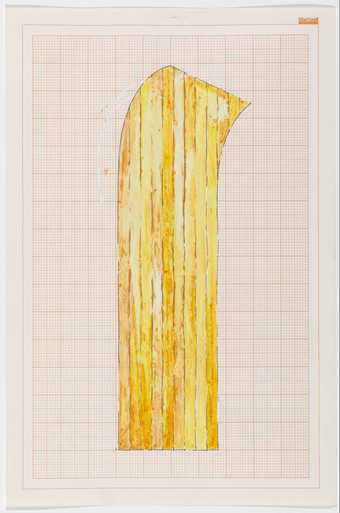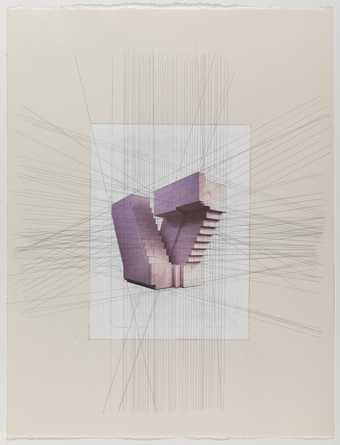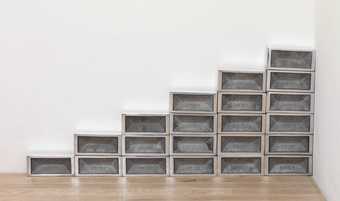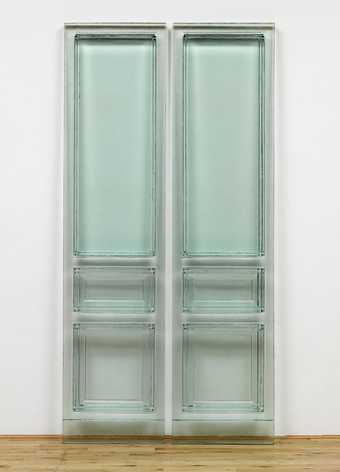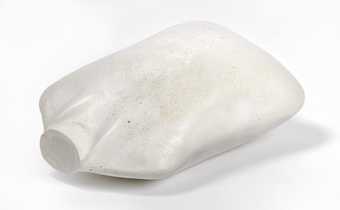
In Tate Britain
Material as Message
Free- Artist
- Rachel Whiteread born 1963
- Medium
- Plaster, fibreglass and wood
- Dimensions
- Object: 3750 × 2200 × 5800 mm
- Collection
- Tate
- Acquisition
- Purchased with funds provided by the Art Fund and Tate Members 2003
- Reference
- T07939
Summary
Untitled (Stairs) is a very large free-standing sculpture made up of ten cast elements bolted together to form a unit. As its title indicates, it is the cast of a staircase, including three square-shaped landings as the stairs zigzag down the stairwell. The artist cast the surface of the stairs and the space above them. She made a 1:10 scale model before the casting in order to envisage the form of the solidified space and to work out how the final sculpture should be positioned. It has been rotated by 90 degrees so that it stands on an edge which would have been a wall in the original space. Whiteread cast the sections making up Untitled (Stairs) using a durable polymer reinforced plaster, known as Jesmonite, combined with layers of fibreglass matting, painted directly onto the surfaces of the stairs, the walls and the enclosing panels which had been fitted against the stair railings to make moulds. The casts are approximately 80mm thick. Although the assembled sculpture has the appearance of a solid block, it is in fact a shell.
Untitled (Stairs) is one of three casts of staircases Whiteread made in a building in Bethnal Green, London E2 which she and her partner purchased as a home and studio in 1999. Originally a synagogue, the building had been reconstructed in the 1950s after bomb damage in the Second World War. As the Jewish population in the area diminished it fell out of use and was taken over by a textile company for warehouse storage in the 1970s. It had been empty for several years when Whiteread acquired it. She began casting spaces in the building in response to a commission by the Guggenheim Museum, who invited her to make works for an exhibition touring its Berlin, Bilbao and New York venues. Although initially thinking about relating the architecture of the different Guggenheim buildings, she decided to use her own architecture instead. In addition to the staircases, Untitled (Basement) 2000 (Guggenheim Museum), Untitled (Stairs)
and Untitled (Upstairs) 2001 (private collection, courtesy the artist and Gagosian Gallery, London), she cast the interior spaces of two purpose-built apartments on the first floor, Untitled (Apartment) 2000 (Guggenheim Museum) and Untitled (Rooms) 2001 (Tate T07938), and the synagogue floor, Untitled (Cast Iron Floor) 2001 (private collection). In this way she preserved the building in the state in which she had found it, before altering it to suit her own needs.
Whiteread had previous experience of casting on an architectural scale from such works as Ghost 1990 (National Gallery of Art, Washington DC), the negative cast of a room in a Victorian house in North London, Untitled (Room) 1993 (Museum of Modern Art, New York), the cast of a room she had constructed in the studio specifically for that purpose, and House 1993 (now destroyed), the internal cast of an entire terrace house in East London. However the staircases provided a new and very particular geometric challenge. In 2001 she explained:
It’s something that I’ve been trying to do for about eight years. What intrigued me about the staircase is that I felt it could be turned on its side ... when I was first thinking about making [it] I didn’t necessarily want to illustrate it as a staircase ... I wanted to try to do something a bit less literal. I made models of the staircase, which helped me realize that I could actually turn things around ... I wanted to try and flip the architecture a little bit. I wanted to change the way one might think about how you walk around or through something ... when we first put the staircase work up in the studio ... I was struck by the sense of physical disorientation it gave me.
(Quoted in Transient Spaces, pp.50-1.)
Whiteread’s casting process has transformed the stairs into an abstracted geometric composition which combines physical familiarity with a mental conundrum – that of trying to envisage the original structure from which the new object has been derived.
Further reading:
Rachel Whiteread: Transient Spaces, exhibition catalogue, Deutsche Guggenheim Berlin 2001
Charlotte Mullins, Rachel Whiteread, London 2004, p.107, reproduced p.106 in colour
Judith Nesbitt and Jonathan Watkins, Days Like These, exhibition catalogue, Tate London 2003, pp.144-9, reproduced pp.149 in colour
Elizabeth Manchester
February 2005
Does this text contain inaccurate information or language that you feel we should improve or change? We would like to hear from you.
Explore
- abstraction(8,615)
-
- from recognisable sources(3,634)
-
- man-made(999)
- non-representational(6,161)
-
- geometric(3,072)
- features(8,872)
-
- stair / step(514)
- synagogue(5)
- house(2,675)
- emotions and human qualities(5,345)
-
- memory(367)
- space(177)
- time(679)
- UK countries and regions(24,355)
-
- England(19,202)
You might like
-
Sir Antony Gormley OBE RA Untitled (for Francis)
1985 -
Rachel Whiteread Untitled (Air Bed II)
1992 -
Rachel Whiteread Untitled (Floor/Ceiling)
1993 -
Sir Antony Gormley OBE RA A Case for an Angel III
1990 -
Rachel Whiteread Untitled (Floor)
1994–5 -
Rachel Whiteread Untitled (Rooms)
2001 -
Rachel Whiteread Untitled (Nine Tables)
1998 -
Rachel Whiteread Untitled (Twenty-Four Switches)
1998 -
Rachel Whiteread Study for (White)
2000 -
Rachel Whiteread Study for Wax Floor
1992 -
Rachel Whiteread Stairs
2003 -
Steven Claydon London Pixel Array 21
2012 -
Rachel Whiteread Due Porte
2016 -
Rachel Whiteread Torso
1988

